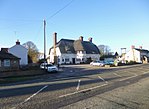Moreton cum Alcumlow
Cheshire geography stubsCivil parishes in CheshireVillages in Cheshire

Moreton cum Alcumlow is a small civil parish in the unitary authority of Cheshire East and the ceremonial county of Cheshire, England. In the census of 2001 it was recorded as having a population of 150. The civil parish holds a parish council meeting under a grouping scheme with the adjacent civil parish of Newbold Astbury, and so it is consequently called Newbold Astbury-cum-Moreton Parish Council. Within the civil parish is the small village of Ackers Crossing, and Alcumlow Hall and Great Moreton Hall (Little Moreton Hall is in the adjacent civil parish of Odd Rode).
Excerpt from the Wikipedia article Moreton cum Alcumlow (License: CC BY-SA 3.0, Authors, Images).Moreton cum Alcumlow
New Road,
Geographical coordinates (GPS) Address Nearby Places Show on map
Geographical coordinates (GPS)
| Latitude | Longitude |
|---|---|
| N 53.133 ° | E -2.236 ° |
Address
New Road
CW12 4SB , Moreton cum Alcumlow
England, United Kingdom
Open on Google Maps








